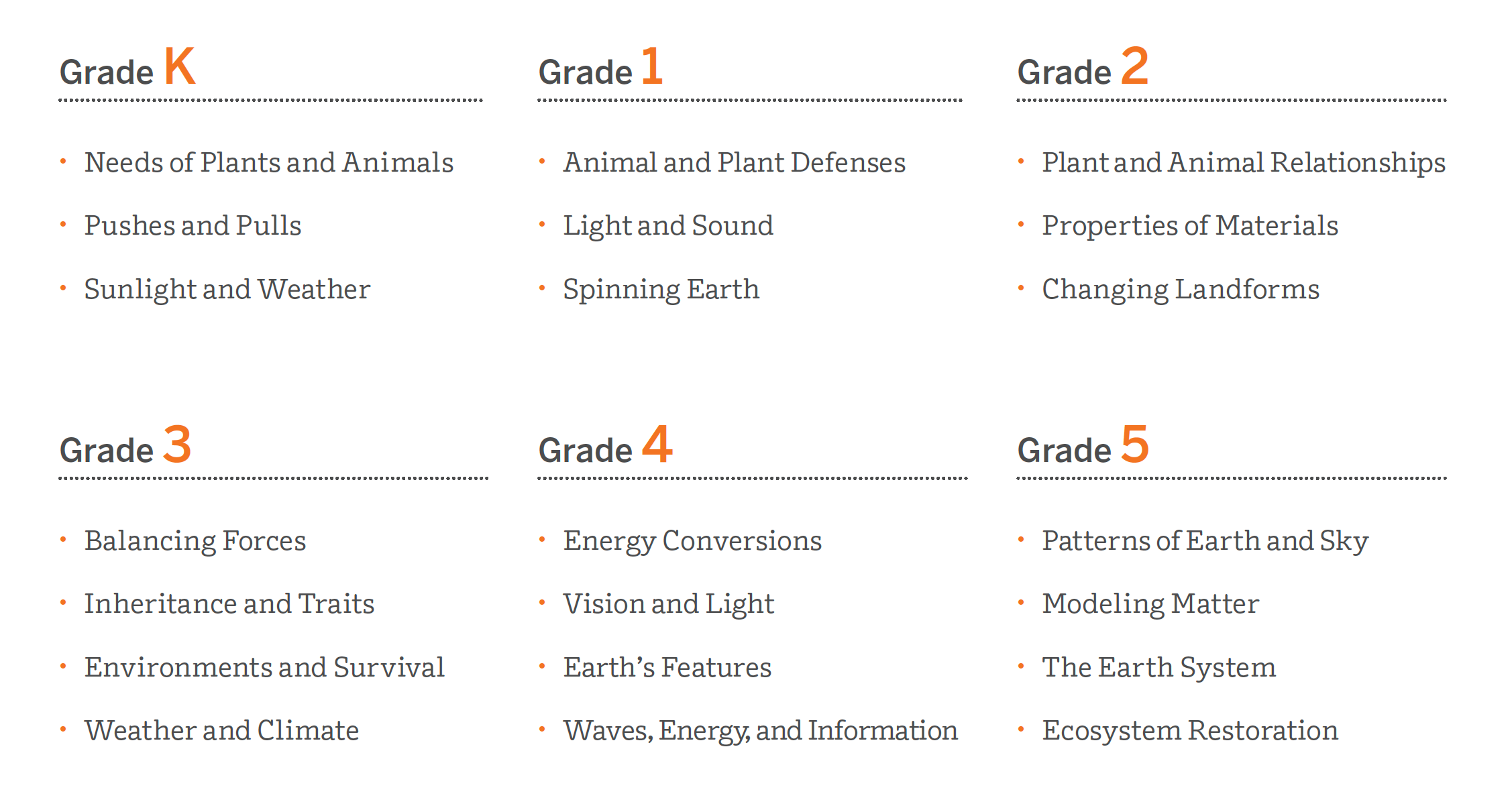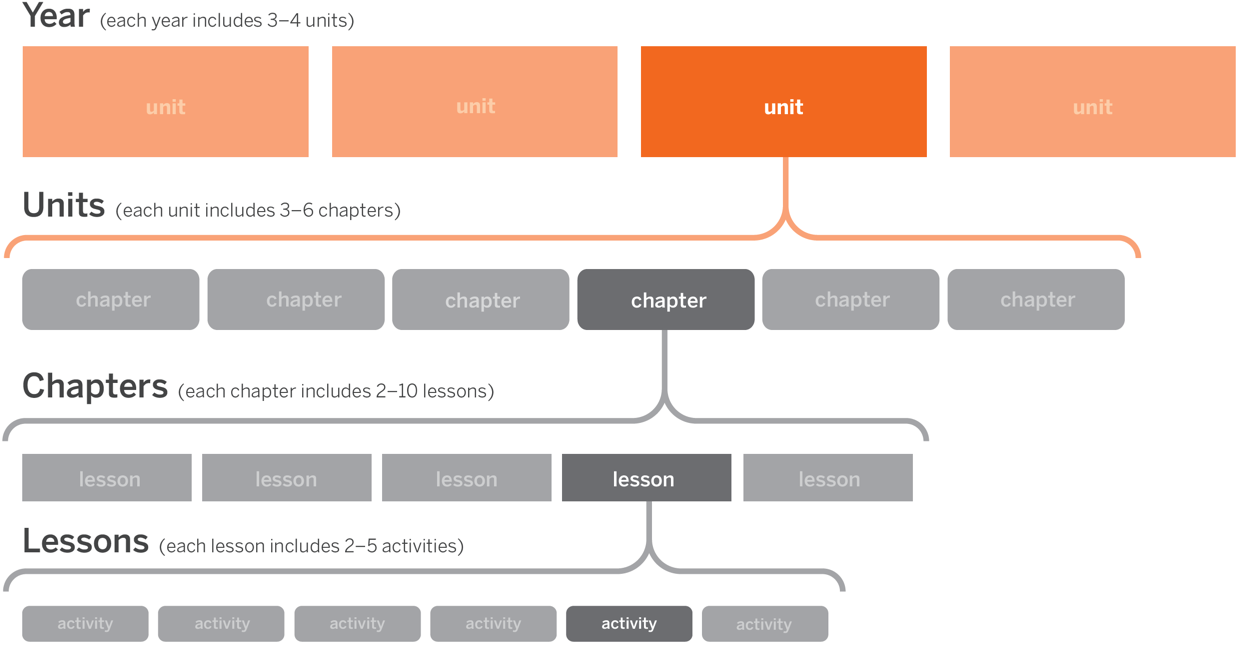Amplify Science K–5
Every year of Amplify Science K–5 consists of 3–4 units, with each unit containing 20 lessons plus two full-session assessments (a Pre-Unit Assessment and End-of-Unit Assessment). Kindergarten and grade 1 lessons are written for 45-minute sessions, and grades 2–5 lessons are written for 60-minute sessions — though teachers can expand or contract the timing to meet their needs.

Elementary School navigation structure:
The Amplify Science curriculum is intuitively organized and was specifically designed to be easy to navigate. Each year contains units, which contains chapters, which contain lessons, which contain activities.

In each K–5 course, there is one unit that emphasizes investigation, one that emphasizes modeling, and one that emphasizes design. In addition, in grades 3–5, there is also one unit that emphasizes argumentation. See below for more information on each unit type.
Investigation units
Investigation units focus on the process of strategically developing investigations and gathering data to answer questions. Students are first asked to consider questions about what happens in the natural world and why, and are then involved in designing and conducting investigations that produce data to help answer those questions. Students analyze the data to construct patterns and principles to answer the questions. As the unit unfolds, these answers help students make progress toward answering the Unit Question and also lead to new investigations to answer new questions. As students move up the elementary grades, they focus on important aspects of the practice of planning and carrying out investigations in an intentional sequence.
Each Amplify Science unit that is focused on investigation also focuses on a specific aspect of the practice of planning and carrying out investigations (a focal practice) and supports students in learning about and using that focal practice. For example, for the grade 4 Vision and Light unit, the focal practice is controlling variables. The unit thus focuses students, in particular, on changing only one variable at a time as they investigate. Students learn that this is how scientists can figure out which variable makes a difference.
The investigation units include multiple opportunities for students to analyze or plan the methods of an investigation to gather data to answer a question, by:
- Identifying or formulating the investigable question.
- Identifying or hypothesizing the important variables and how they will be consistently measured and recorded.
- Analyzing or deciding how data is organized to look for possible patterns.
| Grade | Investigation unit |
|---|---|
| Kindergarten | Needs of Plants and Animals |
| Grade 1 | Spinning Earth |
| Grade 2 | Plant and Animal Relationships |
| Grade 3 | Inheritance and Traits |
| Grade 4 | Vision and Light |
| Grade 5 | Patterns of Earth and Sky |
Modeling units
The field of science education has recognized the crucial role that models play in scientists’ work, and thus the role they can play in students’ learning. Models can be physical or virtual constructions that scientists make because it is difficult or impossible to investigate the real thing. Models can also be the descriptions, diagrams, or equations that scientists use to represent their ideas about how a situation in the natural world works. Modeling units make these constructions or representations a central focus, engaging students in making, using, and evaluating models to build knowledge.
The K–5 modeling units include multiple opportunities for students to use or develop visual and physical representations of phenomena in order to:
- Actively interpret them to determine ideas important to understanding the phenomenon.
- Investigate how they work to make inferences about the phenomenon.
- Communicate the ideas relevant to understanding a phenomenon to a particular audience.
Each Amplify Science modeling unit targets a specific aspect of developing and using models (called a focal practice), and supports students in learning about and using that practice. For example, in the grade 4 Waves, Energy, and Information unit, the focal practice is representing materials at the particulate level through models. Students use physical models, investigate with computer models, and create their own diagrams to help them visualize what might be happening on the nanoscale. As students move up the K–5 grades, they focus on important aspects of the modeling practice in an intentional sequence.
| Grade | Modeling unit |
|---|---|
| Kindergarten | Sunlight and Weather |
| Grade 1 | Animal and Plant Defenses |
| Grade 2 | Changing Landforms |
| Grade 3 | Balancing Forces |
| Grade 4 | Waves, Energy, and Information |
| Grade 5 | Modeling Matter |
Engineering design units
Engineering design involves a combination of applying science principles in order to design functional solutions, and iteratively testing those solutions to determine how well they meet the design criteria set by users or stakeholders. Design units make developing these solutions the central focus.
In the Design units, students construct an understanding of science ideas from investigation and text and apply those science ideas in designing solutions to an engineering problem. Students then test and/or evaluate their solutions to see how well they meet a set of design criteria. As students move up the elementary grades, they focus on important aspects of engineering practice in an intentional sequence.
Each Amplify Science unit that is focused on design also focuses on a specific aspect of the practice of engineering design (a focal practice), and supports students in learning about and using that practice. For example, the grade 3 Environments and Survival unit focuses students on iteratively planning, designing, and testing a solution to a problem. The focal practice in the unit is using ideas to plan designs. Specifically, students draw on ideas they have learned about organisms’ traits to inspire them as they help a fictitious engineering firm design a robot that will help mitigate the effect of an environmental change.
All engineering design units are motivated by an engineering task that has particular criteria for success, where students will:
- Develop and articulate science ideas relevant to intentional construction and/or testing of a solution.
- Construct or revise (prototype) solutions at multiple points during the unit.
- Evaluate solutions in relation to criteria for how well it/they meet them.
| Grade | Engineering Design Unit |
|---|---|
| Kindergarten | Pushes and Pulls |
| Grade 1 | Light and Sound |
| Grade 2 | Properties of Materials |
| Grade 3 | Environments and Survival |
| Grade 4 | Energy Conversions |
| Grade 5 | The Earth System |
Argumentation units
Argumentation is the process by which scientists figure out the best answer to a question based on the available evidence. While data has a fundamental role in science, scientists also recognize that their predecessors undertook their own careful investigations, and deliberated the possible answers through argumentation with their colleagues, to arrive at a set of supported and accepted ideas. Scientists draw on these ideas as evidence, taking them from texts and other sources they trust as credible, and incorporating them into the arguments for or against particular claims. Amplify Science trains students to do the same. While all Amplify Science units engage students in the practice of using evidence to support answers to scientific questions, argumentation units in grades 3–5 make this effort a central focus by including regular opportunities for students to explore and discuss available evidence; providing time and support to consider how evidence may be leveraged in support of claims; and gradually increasing independence as they mount their own written arguments in support of a claim.
Each Amplify Science unit that is focused on argumentation also targets a specific aspect of the practice (a focal practice), and supports students in learning about and using that practice. For example, in the grade 4 Earth’s Features unit, the focal practice is drawing on accepted science ideas to show how empirical data supports a claim. As students move up the K–5 grades, they focus on important aspects of argumentation in an intentional sequence.
The argumentation units provide students with multiple opportunities for:
- Considering the quality of evidence.
- Evaluating claims in relation to evidence.
- Marshaling evidence in support of a claim.
- Participating in oral argumentation with their peers.
- Constructing written arguments to convince a specific audience.
| Grade | Argumentation unit |
|---|---|
| Grade 3 | Weather and Climate |
| Grade 4 | Earth’s Features |
| Grade 5 | Ecosystem Restoration |